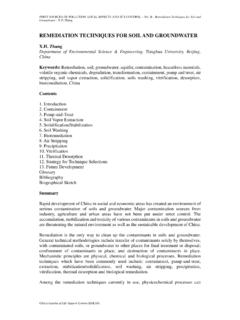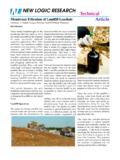Transcription of Arsenic: Mitigation Strategies. - US EPA
1 1 ArsenicMitigation strategies The purpose of this training session is acquaint Primacy Agency decision makers, technicalassistance providers, and other public health officials with the requirements of the final ArsenicRule. This presentation covers strategies systems can use to lower the amount of arsenic in finishedwater. It is one part of an overall training session on the arsenic Rule conducted by EPA during2002. Other presentations cover the disposal of residuals generated by arsenic treatment,monitoring and reporting and other arsenic Rule topics.
2 This presentation is based on EPA s draft document arsenic Treatment Technology DesignManual for Small Systems. The document summarizes available data and presents it in an easy-to-use format. The manual and the decision trees were designed to help a system operator,assistance provider, or regulator determine whether a system has an arsenic problem and the bestmethods for mitigating. The Design Manual also includes detailed cost and labor estimates. Other useful resources on arsenic treatment are available through the EPA Office of GroundWater and Drinking Water s arsenic web page at see the EPA Office of Research and Development s web page In addition, the American Water Works Association (AWWA)
3 Is developing a book thatexamines arsenic treatment technologies, however, it is not focused as much on small systemsand is more technical in Summary BAT arsenic Arsenite Speciation Oxidation Monitoring andplanning Zero treatmentoptions Treatment options Existing technologies New technologies Most likely newtechnologies Piloting Regulatoryconsiderations POE/POU Workshop This presentation is structured as discussion of best available technologies (BAT). This segment is brief becausemost small systems impacted by the arsenic Rule will probably not use a of arsenic chemistry.
4 The difference between arsenite [ arsenic (III)] andarsenate [ arsenic (V)] will impact discussion of monitoring and planning. Most systems, especially early on, need tothink about monitoring as part of their planning of zero treatment options, which are preferable where they are discussion of treatment options, including a discussion of technologies thatare the most promising for small of pilot issues will be considered throughout the , an introduction to point-of-use (POU) treatment presentation is meant to be accompanied by a treatment technology workshop, inwhich training participants use the decision trees from this presentation to makesuggestions about appropriate technologies for a series of example AvailableTechnologies (BAT) High removal efficiency History of full-scale operation General geographic applicability Reasonable cost based on largesystems Reasonable service life Compatibility with other treatmentprocesses Able to bring all of a system s water intocompliance Section 1412(b)
5 (4)(E) of the Safe Drinking Water Act (SDWA) states that each NationalPrimary Drinking Water Regulation (NPDWR) which establishes an Maximum ContaminantLevel shall list the technology, treatment techniques, and other means that the Administratorfinds to be feasible for purposes of meeting the MCL. Technologies are judged to be a BATwhen the following criteria are satisfactorily met:(1) The capability of a high removal efficiency;(2) A history of full-scale operation;(3) General geographic applicability;(4) Reasonable cost based on large and metropolitan water systems;(5) Reasonable service life;(6) Compatibility with other water treatment processes; and,(7) The ability to bring all of the water in a system into compliance.
6 Systems are not required to use BATs to achieve compliance with an MCL. Any technologythat is accepted by the State primacy agency and achieves compliance with the MCL is , if a system is unable to meet the MCL with its chosen technology, the system is noteligible for a variance unless it has installed a BAT and still cannot achieve compliance. Formore information on variances and exemptions see the arsenic State Implementation Guidance(EPA 816-K-02-018) at ! % RemovalActivated Alumina95 Coagulation/Filtration95 Ion Exchange95 Lime Softening90 Reverse Osmosis>95 Electrodialysis85 Oxidation/Filtration80 EPA identified 7 BATs in the Final arsenic Rule using its listed criteria (66 FR 6976 at 6981).
7 EPAdetermined these technologies to be the BATs for the removal of arsenic in drinking water based on ademonstration of efficacy under field conditions taking cost into consideration (40 CFR (c) andSDWA 1412(b)(4)(D)). All of these BATs are for arsenic V. Pre-oxidation may be required to convertarsenic III to arsenic V (40 CFR (c)). This table shows the seven BATs identified by EPA in the Final arsenic Rule and also the maximumpercent of arsenic removal that can be reasonably obtained from these technologies. Thesetechnologies include: Activated Alumina, with a maximum removal of 95%; Coagulation/Filtration (not BAT for systems with fewer than 500 service connections), with amaximum removal of 95%; Ion Exchange, with a maximum removal of 95%; Lime Softening (not BAT for systems with fewer than 500 service connections), with amaximum removal of 90%; RO, with a maximum removal of over 95%; Electrodialysis, with a maximum removal of 85%; and, Oxidation/filtration, with a maximum removal of 80%.
8 To obtain high removal rates withoxidation/filtration, the iron to arsenic ratio must be at least 20:1 (40 CFR (c)). A brief discussion of the major issues surrounding the usage of each technology is given in thepreamble to the Final arsenic Rule. More details about the treatment technologies and costs can befound in EPA s Technologies and Costs for the Removal of arsenic From Drinking Water, System ComplianceTechnologies in 40 CFR (d)Treatment Technology Affordable for listed category Activated Alumina (central, POU, POE) All size categories Ion exchange All size categories Oxidation/Filtration All size categories Coag Assisted Micro 501-3,300 and 3,301-10,000 Reverse Osmosis (central) 501-3,300 and 3,301-10,000 Reverse Osmosis (POU)
9 All size categories Coagulation/Filtration 501-3,300 and 3,301-10,000 Lime Softening 501-3,300 and 3,301-10,000 The technologies examined for BAT determinations were also evaluated as small systemcompliance technologies (SSCTs). EPA must list SSCTs for three sizes of small systems:systems serving between 25 and 500 people, systems serving between 501 and 3,300 people,and systems serving between 3,301 and 10,000 people (SDWA 1412(b)(4)(E)(ii)). EPA haslisted SSCTs that may achieve compliance with the arsenic MCL and that are affordable andapplicable to small drinking water systems.
10 This table identifies the SSCTS and the system size categories for which they are SSCTS. Because EPA has listed SSCTs, small systems: Will have the latitude to choose the type of treatment technology that is most costeffective and appropriate (from an operation and maintenance standpoint). Are not eligible for a small system variance since EPA has determined that SSCTs existfor all three system size categories. May be eligible for a general variance under SDWA 1415(a) if they have installed oragreed to install the BAT but, due to source water quality, will not be in compliance withthe MCL.













